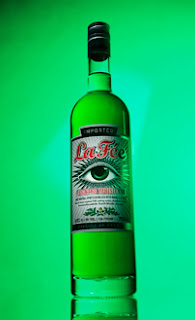A case for Absinthe
 Anyone reading alcohol blogs on a regular basis may already be sick of hearing about Absinthe. It seems every new alcohol blog has to make some moronic post about Absinthe in the early months of its existence, only to never hear about the stuff ever again.
Anyone reading alcohol blogs on a regular basis may already be sick of hearing about Absinthe. It seems every new alcohol blog has to make some moronic post about Absinthe in the early months of its existence, only to never hear about the stuff ever again.The New York Times has just put up an article from The Curious Cook who was going after Ernest Hemingway's "Death in the Afternoon." A champagne and Absinthe recipe that not only tells you how to make it, but how many you need to drink (3-5).
Apparently, the unique drink turns two clear liquids in to a cloudy one because the aromatics seem to be more soluble in alcohol than water, so when you put absinthe in wine, it clusters together and gives it a milky look. Yummy!
The article also discusses just how dangerous Absinthe is (not very), what drug it's most like (marijuana), and how it probably wasn't the active ingredient, Thujone, that killed everyone way back when.
It also goes in to the details of why the drink gets cloudy, which I would love to explain to you, but it would require me to return to college.
Trying to Clear Absinthe's Reputation

Comments